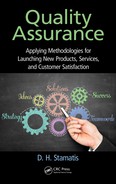
560 Appendix V
Why
• Higher throughput (increases capacity) decreasing total DTD times
• More stable processes improve production predictability, therefore
improving build-to-schedule
• Higher throughput and lower rework/scrap leads to improved FTT
and total cost
Where
OEE should be measured on machines in your constraint operations.
When
Data should be collected by shift and by product or job if applicable. OEE
data should be reviewed daily, and trended over time to identify improve-
ment opportunities and verify the effectiveness of process changes.
Special consideration: OEE data must not be used to compare plant-to-
plant performance. Too many variables exist in physical environments,
facility layout, and machine/process uniqueness, to compare on a valid
basis.
OEE Availability × Performance Efciency × Quality
Availability
Operating Time
Net Available Time
Performance efciency
Ideal Cycle Time − Total Parts Run
Operating Time
Quality
Total Parts Run − Total Defects
Total Parts Run
OEE Calculation Example
Availability
Total schedule time (including overtime) 720min
Required downtime (e.g., 30min lunch;
30min breaks, etc.)
30 + 30 = 60 min
Net available time
720 − 60 = 660 min
All other downtime (e.g., machine
downtime and die changes)
45 + 45 = 90 min
(Continued)

561Appendix V
Operating time 660 − 90 = 570min
Availability
570
660
= 86.3%
Performance Efficiency
Ideal cycle time 0.33min/part
Total parts run 1440
Operating time 570min
Performance (0.33 × 1440) = 83.4%
Efciency 570
Quality Rate
Total parts run 1440
Rework 50
Scrap 40
Quality rate
1440− (50+ 40)
1440
= 93.8%
Overall Equipment Effectiveness
Availability 86.3%
Performance efciency 83.4%
Quality rate 93.8%
OEE 0.863 × 0.834 × 0.938
OEE 67.5%
Quick Changeover
Quick changeover is a method for people to analyze and signicantly reduce
setup and changeover time. Changeover time is the time between the last
good piece off one production run and the rst good piece off the next pro-
duction run after the changeover.
Internal: Activities performed while the machine is shut down.
External: Activities performed while the machine is safely running.

562 Appendix V
Changeover Time
1 Run A External Internal External Run B
Start: Document current changeover elements
2 Run A Internal Run B 50% reduction
Separate internal/external activities
3 Run A Internal Run B 75% reduction
Shift internal activity to external
4 Run A Internal Run B 90% reduction
Streamline internal and or external activities
Quick Changeover Process
1. Document current changeover process
a. Document each element (consider photos/video)
b. Time the process and the elements
c. Establish baseline
2. Separate internal and external activities
a. Internal activities must be performed while the machine is
down
b. External activities can be performed while the machine is
running
3. Shift internal activities to external
a. Analyze each element
b. Ask 5 Whys
c. Resolve if the element can be made external
4. Locate parallel activities
a. Tasks that are independent of each other can be performed
simultaneously
b. Changeover time can be reduced signicantly by doing jobs in
parallel (simultaneously)
5. Streamline internal/external activities
a. Adjustment elimination
b. Fixtures and jigs
c. Functional standards
d. Quick die change hardware
6. Implement the revised plan
a. Examine feasibility of all ideas
563Appendix V
7. Validate the method/verify the results
a. Develop draft procedures
b. Test procedures
c. Verify results with data
8. Document the new method on a standard worksheet
a. One standard worksheet for external
b. One for each set of parallel internal activities
9. Notify other areas
Visual Factory
A visual factory is a facility in which anyone can know in 5min or less the
who, what, where, when, how, and why of any work area, without talking to
anyone, opening a book, or turning on a computer.
Visual Factory Levels
Visual Display
Level 1: Share information. Sharing all information about activities lets
everyone see how closely performance conforms to expectations.
Level 2: Share standards at the site. Sharing information about stan-
dard specications and methods lets everyone identify nonconfor-
mance as it occurs and helps to correct it.
Visual Controls
Level 3: Build standards into the workplace. Make the work environ-
ment (space limits, standard containers, equipment barriers) com-
municate established standards.
Level 4: Warn about abnormalities. Incorporate lights, alarms, bells,
buzzers, and other devices that alert workers when an abnormality
is detected, such as a defect generated or a shortage of parts.
Level 5: Stop abnormalities. Prevent defects from moving on after
detection by stopping the process or rejecting the part. Devices are
installed at the source of abnormalities.

564 Appendix V
Level 6: Prevent abnormalities. Level 6 means 100% prevention of
abnormalities. Once the exact cause of a defect is known, an error-
proong device is installed to prevent the defect from occurring
at all.
Five Steps to Workplace Organization
• Step 1: Sort (organization)
• Distinguish between what is needed and what is not needed.
• Step 2: Stabilize (orderliness)
• A place for everything and everything in its place.
• Determine the best location for all necessary items.
• Step 3: Shine (cleanliness)
• Eliminating dirt, dust, uids, and other debris to make the work
area clean.
• Adopting cleaning as a form of inspection.
• Step 4: Standardize (adherence)
• Maintain and monitor the rst three S’s.
• Check/standardize/maintain/monitor/improve
• Step 5: Sustain (self-discipline)
• Correct procedures have become habit.
• The workplace is well ordered according to agreed-on procedures.
• Manager, operator, and engineers are deeply committed to 5S.
Error Proofing
Error proong is a process improvement to prevent a specic defect from
occurring.
Three Sides of Error Proofing
Physical: Install hardware
Operational: Enforce procedure, sequence, and/or execution
Philosophical: Empowerment of workforce
..................Content has been hidden....................
You can't read the all page of ebook, please click here login for view all page.
